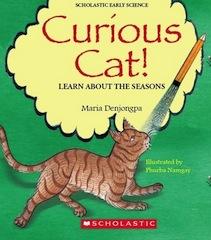

As, a legacy of our British education we have all been taught that there are 4 seasons – along with the images depicting those seasons; snowmen grinning under their carrot noses, spring blossoms, autumn winds blowing fallen leaves, and children lolling, under a beach umbrella under a smiling summer sun. We are made to believe that these four seasons are universal and so if anyone asks, “Name the seasons, we immediately rattle off, “Spring, summer, autumn, winter,” without stopping to think whether those seasons actually reflect our own reality. For example, most places of India experience only 3 seasons – summer, monsoons and winter. Similarly, for people living along the equator the only season they must experience is year-round summer.
So, it is refreshing to see a book that breaks away from the streotypical images of the seasons and place before the reader the reality of other seasonal patterns.
As, the teacher is talking of flowers blooming in spring, Sonam, the curious cat, remembers how in her hometown in Sikkim, Spring was a season during which hailstones came crashing down, destroying the vegetables that her mother had carefully planted in the garden. And when the teacher tells the class about the sunny days of summer, Sonam recalls how during summertime, the sky filled up with grey clouds and they experienced heavy downpours!
An excellent book for children to read and deliberate on how different peoples live in different conditions, and how their lives have adapted to around those weather patterns.
Beautiful illustrations in the Thangka style of scroll paintings, add richness to the texture and the narration of the book.
Comments
Sonam, the Curious Cat is
Sonam, the Curious Cat is confused and wonders why the seasons in the text book did not match the seasons in Sikkim. Using his creative and critical thinking skills he paints the seasons prevailing in Sikkim.
A valuable resource for teachers to introduce children to seasons, changes taking place during each season and how the season in India differs with other parts of world. The delightful story invites children to develop their natural curiosity to investigate and encourages comparison of concepts with their surroundings.
Contributed by Chaitali Shirali. She is a librarian at Bombay International School.